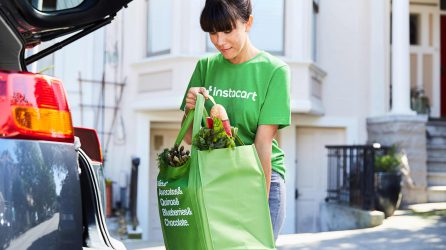Out of luck with out-of-stocks? How to monitor availability and protect your retail SEO

Presented by:
Stephanie Rubin — 2022
This post has been updated and was originally published December 21, 2021.
There’s no escaping stockouts right now. US consumers saw more than two billion out-of-stock messages online in October, as retailers and brands battled to keep shelves stocked ahead of the festive shopping season. That’s a 250% increase on pre-pandemic levels.
The reasons are well rehearsed by now. Ever since the coronavirus outbreak, global supply chains have been disrupted by a string of shocks. Demand for CPG products skyrocketed at the start of the pandemic and has remained high, while raw materials and labor shortages have pushed up production costs and created huge manufacturing and logistics challenges.
Although retailers and CPGs have done a remarkable job keeping shelves stocked in tough conditions, availability has inevitably been hit. More than half of US retailers say out-of-stocks are the biggest challenge they’ve faced in the wake of Covid, and some regional grocery chains have reported receiving as little as 40% of their orders. In a recent Consumer Brands/Ipsos poll, 62% of Americans said they were concerned about CPG product shortages in the next few months.
With disruption expected to continue well into 2022, now’s the time to take a fresh look at your availability monitoring to ensure you’re doing everything possible to minimize stockouts and keep service levels high.
Understanding the impact of out-of-stocks online
Robust availability monitoring is critical because CPGs can pay a high price for stockouts, especially on the digital shelf.
When you go out of stock online, you’re not just losing out on a potential sale. You’re not just wasting money you’ve already invested into getting your listing and getting your product on shelf and into the warehouse. And you’re not just frustrating the shopper, undermining brand loyalty, and potentially gifting a sale to a competitor. You could lose your listing altogether.
Some retailers will simply pull the plug on your online listing if you’re out of stock for a certain amount of time. This means all the digital assets you’ve built up for that listing are lost as well and need to be rebuilt. You’re essentially back to square one.
Even if you don’t lose your listing, being out of stock can seriously hurt your retail SEO. Some retailers will relegate you to the bottom of the search page if you’re out of stock, which means you lose all visibility. What’s more, your rate of sale will decline if you’re out of stock for an extended period of time, which, in turn, will further hurt your search performance. That’s because rate of sale is one of the factors retailers’ search algorithms take into account when determining organic search results.
The final killer comes from favorites and past purchases. If a shopper has substituted your product, that competitor product will now be in their favorites or ‘last bought’. As a large proportion of online baskets are built from favorites and past purchases (nearly 90% of US online grocery shoppers say they use their order history to reorder items they’ve bought in the past) this means you’ve not only lost sales at that one particular point in time – you’ll be losing future sales as well.

5 tips to safeguard your availability and retail SEO
To protect yourself and your retail SEO from this chain of knock-on effects, I recommend focusing on five key areas.
- Start monitoring more frequently. Most CPGs I work with have solid monitoring practices in place, but they’re not necessarily monitoring enough. Weekly reporting cycles are fine during more normal times, but right now daily reporting is often needed.
- Make sure responsibility for out-of-stocks is shared and your teams communicate well across functions. Working in silos will trip you up. Stay particularly close to the manufacturing side, so you understand what’s being shorted and where, and how this affects your availability.
- Monitor availability at store level. Big-picture data is great, but in the current climate you also need a more granular view. At e.fundamentals, we recently added a multi-store gather tool to our availability and assortment insights that clients can upgrade to; it gives you a view of your availability by brand and by SKU across stores. It’s a great way to see the big gaps in the big stores for the big products. Plus, you can download everything and integrate it with your ‘golden stores’ lists for eCommerce and in-store to get multichannel learnings.
- Make sure you have enough facings in key pick-from-store locations. You don’t want a successful eCommerce SKU competing with your in-store customers because you haven’t managed to secure enough facings in store. Getting a decent number of facings for eCommerce products can be a challenge, so you need to ensure your team knows how to use digital shelf data to sell that in.
- Put your best-stocked SKUs into paid-for search and manage them daily. At most retailers, the paid-for search algorithm won’t allow out-of-stock products to show anyway, but that’s no reason to take your eye off the ball. As soon as you’ve gone out of stock, that product will come out of paid search, so you need to have other products ready to take the spot. Something as simple as not having the right product list tagged could trip you up, so it’s essential to manage and review on a daily basis.
Of course, CPGs are also having to consider more fundamental steps to safeguard availability. Some have already chosen to rationalize their manufacturing to focus on those SKUs that are highest in demand or create the most category value. Minimizing waste is also key. Every pallet is important right now, so packaging needs to be robust to prevent accidental damage or ullage.
Finally, promotional mechanics continue to be an important focus. Many sectors and companies have already stepped away from volume promotions, but it’s a good idea to double-check there’s nothing potentially problematic lurking in any of your upcoming promotional plans, and to review plans monthly.
As so often, prevention is better than cure. It can be difficult to fix stockouts once they’ve occurred, but regular, targeted monitoring will help you spot potential problems before they escalate and undermine your visibility on the digital shelf.
All the digital Shelf Analytics You Need to Succeed at Speed & Scale
See why world leading brands choose e.fundamentals for actionable digital shelf insights
Request A demoLatest Resources

CommerceIQ Launches Global Retail Ecommerce Management Platform Combining Sales, Supply Chain, Retail Media, and Digital Shelf with e.fundamentals Acquisition
Ecommerce platform enables consumer brands to grow market share profitably in today’s inflationary and supply-constrained environment through intelligent automation, supporting over 450 omnichannel retailers in 41 countries.

e.fundamentals becomes a CommerceIQ company
e.fundamentals has been acquired by CommerceIQ, the leading Retail Ecommerce Management Platform, headquartered in Palo Alto, California. Consumer brands can now harness one global software platform to power profitable market share growth across all major retailers.

5 strategic pricing opportunities CPGs should focus on now
As tensions run high between retailers and suppliers, CPGs need to be smarter than ever about strategic pricing. Here’s how to use digital shelf analytics to hold your own in tough negotiations.

What the smartest CPGs get right about selling on Instacart
This post has been updated and was originally published March 30, 2021. It's time CPGs get ready to win on Instacart. So read and learn: What's all the hype around…

5 optimization tactics to grow digital shelf sales
This post has been updated and was originally published May 14, 2020. Consumer goods companies (CPG) continue to grapple with enormous shifts to the industry as the eCommerce boom continues…

5 tactics to grow online sales for category managers
Category management has changed. We've highlighted the 5 tactics to help you scale your growth on the digital shelf at speed.
View Our Most Popular resources to help you learn and win on the digital shelf.

The Ultimate Guide to Content Management on the Digital Shelf

The Digital Shelf Cast - Listen to our latest episode





